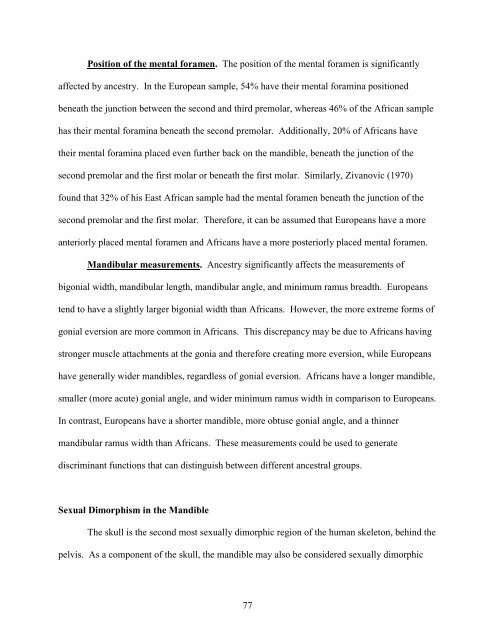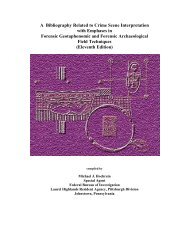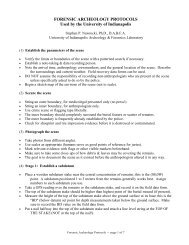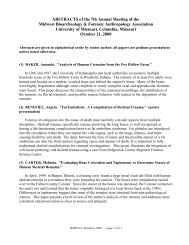Christopher W. Schmidt - University of Indianapolis Archeology ...
Christopher W. Schmidt - University of Indianapolis Archeology ...
Christopher W. Schmidt - University of Indianapolis Archeology ...
You also want an ePaper? Increase the reach of your titles
YUMPU automatically turns print PDFs into web optimized ePapers that Google loves.
Position <strong>of</strong> the mental foramen. The position <strong>of</strong> the mental foramen is significantly<br />
affected by ancestry. In the European sample, 54% have their mental foramina positioned<br />
beneath the junction between the second and third premolar, whereas 46% <strong>of</strong> the African sample<br />
has their mental foramina beneath the second premolar. Additionally, 20% <strong>of</strong> Africans have<br />
their mental foramina placed even further back on the mandible, beneath the junction <strong>of</strong> the<br />
second premolar and the first molar or beneath the first molar. Similarly, Zivanovic (1970)<br />
found that 32% <strong>of</strong> his East African sample had the mental foramen beneath the junction <strong>of</strong> the<br />
second premolar and the first molar. Therefore, it can be assumed that Europeans have a more<br />
anteriorly placed mental foramen and Africans have a more posteriorly placed mental foramen.<br />
Mandibular measurements. Ancestry significantly affects the measurements <strong>of</strong><br />
bigonial width, mandibular length, mandibular angle, and minimum ramus breadth. Europeans<br />
tend to have a slightly larger bigonial width than Africans. However, the more extreme forms <strong>of</strong><br />
gonial eversion are more common in Africans. This discrepancy may be due to Africans having<br />
stronger muscle attachments at the gonia and therefore creating more eversion, while Europeans<br />
have generally wider mandibles, regardless <strong>of</strong> gonial eversion. Africans have a longer mandible,<br />
smaller (more acute) gonial angle, and wider minimum ramus width in comparison to Europeans.<br />
In contrast, Europeans have a shorter mandible, more obtuse gonial angle, and a thinner<br />
mandibular ramus width than Africans. These measurements could be used to generate<br />
discriminant functions that can distinguish between different ancestral groups.<br />
Sexual Dimorphism in the Mandible<br />
The skull is the second most sexually dimorphic region <strong>of</strong> the human skeleton, behind the<br />
pelvis. As a component <strong>of</strong> the skull, the mandible may also be considered sexually dimorphic<br />
77








